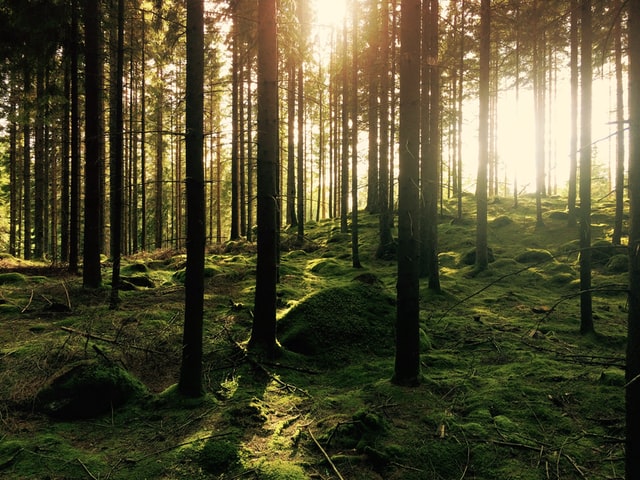
Tour One: The Environment
Protecting the Forest
Did you know that if you asked people from Alaska, Texas, California or Vermont, or even as far as Brazil, South Africa, Japan or England, to close their eyes and imagine they were hiking in a forest, they would probably all picture very different places?
Climate, altitude, soil, and humidity affect how forests grow and look around the world. Finnish forests, which grow in a northern climate, are different from forests that grow in a warmer or more humid environment. Only around 20 species of trees grow naturally in Finland. Tropical forests can grow hundreds of species of trees.
Finland is one of the most heavily forested countries in the world. Three-fourths of Finland is covered with forest. Forests are easily accessible to everyone and they form a beautiful landscape that changes with the seasons. In summer, they are dense with green leaves and in winter they lie under the white cover of snow.
Forests are an important renewable resource: If tended properly and wisely, they will always grow new trees. Some people call forests the “lungs of the Earth” because they produce the oxygen that people and animals breathe. Trees also absorb carbon dioxide from the air and prevent it from trapping the sun’s energy and warming the Earth. The root systems of trees and the canopies created by their leaves protect surface soil from wearing away. By protecting the climate, forests protect life on Earth.
In Finland, forests offer work opportunities and income for forest owners, forest workers, paper mill employees, truck drivers and other people working with wood products. Most forests are used for growing timber. Only a few of the tree species in Finnish forests are, however, economically valuable. They provide raw material for paper production or sawmills.
Many of the species that are not economically valuable still play important roles in the ecosystem. For example, they provide food or homes for birds and insects. Around 10 percent of Finnish forests are legally protected; these conservation areas are used for recreation, research, and to sustain biodiversity.
The government of Finland owns 25 percent of Finnish forests. Companies, churches and other institutions own another 14 percent. And private citizens own the remaining 61 percent of the forests. These people use their forests to make a living (by selling the wood), or for recreation. Basically, someone owns every forest and tree in Finland!
Often, family members own and tend to their forests together. That is why Finnish forestry is often called “family forestry.”
Forests are an important part of Finnish history and cultural heritage. They provide Finns with inspiration and a place for outdoor fun. Two out of every three Finns spend time outdoors weekly. Finns hike, pick berries, cycle and ski in forests. One of every two Finns lives less than a mile away from a forest where you can pick berries or mushrooms.
(But don’t go picking berries and mushrooms from your backyard-they can be poisonous!)
Finns take good care of their forests using methods that copy the forests’ natural life cycles. When trees grow old they are regenerated, meaning old, mature trees are cut down and new seedlings are planted to replace them.
Some forests regenerate naturally when adult trees seed new plants. Others are sowed or planted. Finnish law demands that new trees be planted after every harvest.
Many of the things we enjoy every day come from forests and trees. Look around your home: paper for writing and drawing, paper towels, the pages in books, posters, magazines, furniture, musical instruments, and some toys are made of wood. Wood can also used to build buildings, fences, poles, and decks. Some people carve wood to make statues, bowls or decorations. Others eat with chopsticks made of wood.
What else can you make from wood? The list goes on and on — how “makeeta” (that’s Finnish for COOL)!
QUIZ
- How much of the surface of Finland is covered with forests?
- 2000 feet
- 200,000,000 inches
- 1/2 of the surface
- 3/4 of the surface
2. What does “lungs of the Earth” mean?
- it means that the forest produces oxygen
- it means that the forest produces carbon dioxide
- it means that the forest produces living creatures
- it means that the forest produces hot air
3. How far do half of Finns live from forests with berries and mushrooms?
- 15 feet
- a mile
- two miles
- less than a mile
4. Which are not made of wood?
- chopsticks
- Christmas trees
- knives
- pianos

